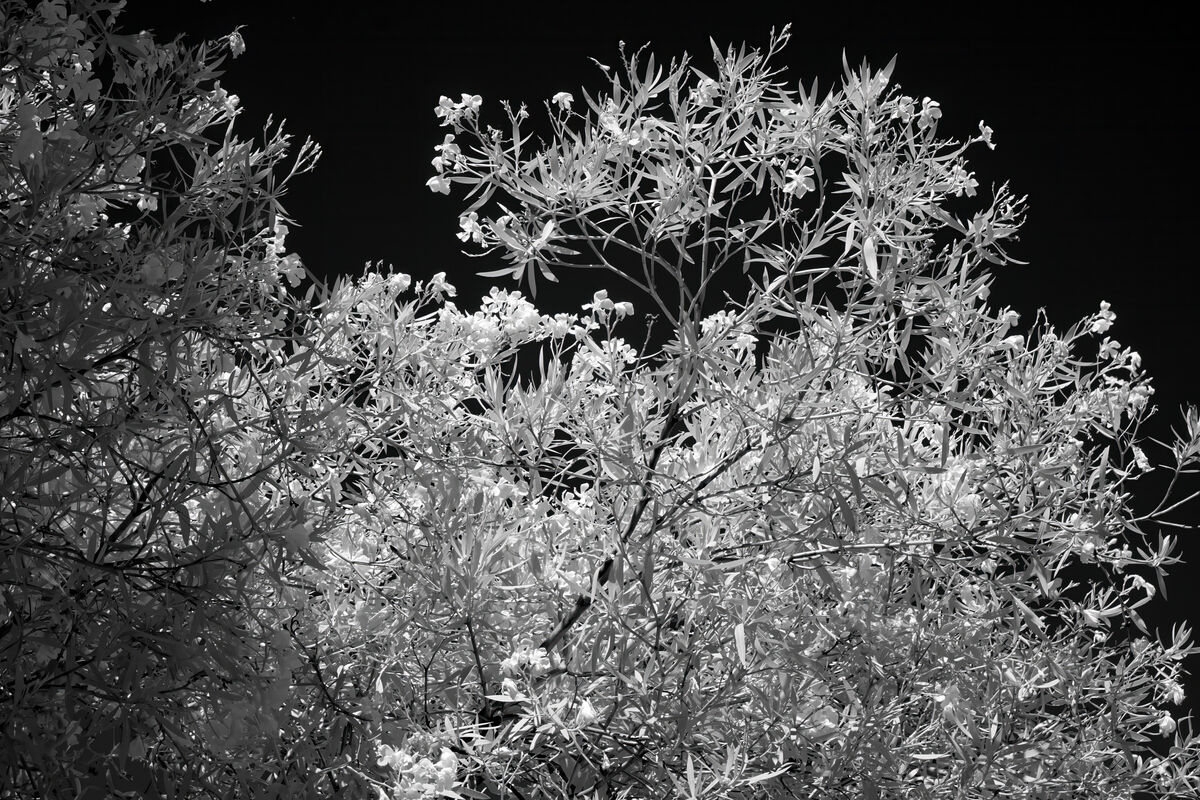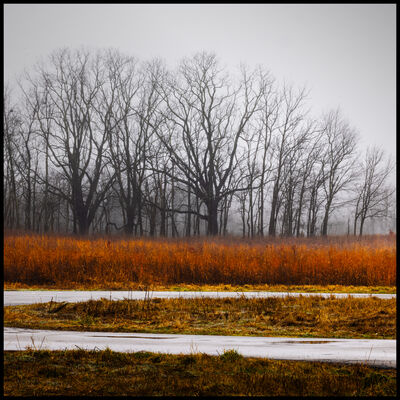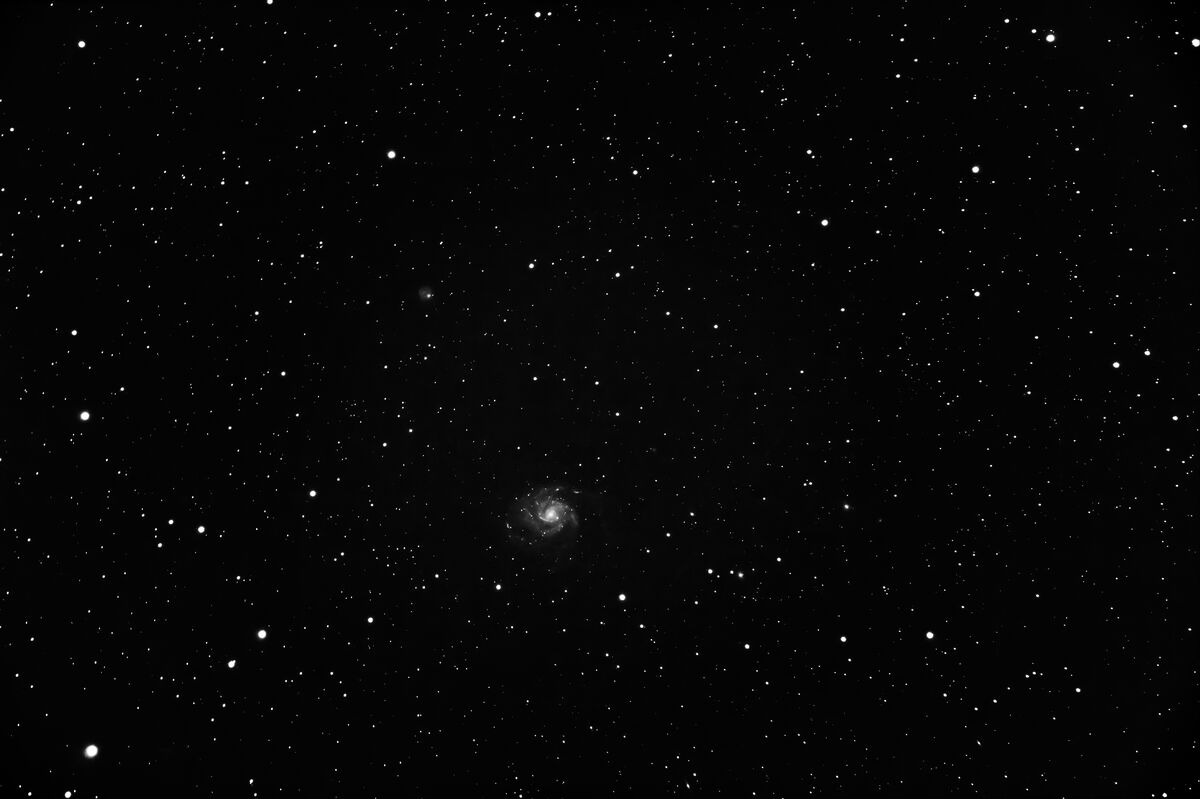Oleander: Lovely but Lethal
Aug 28, 2023 19:04:07 #
The Oleander is common in California. Loves the heat. Not bothered by lack of rain. Blooms almost all year. So what's the problem? It contains toxic cardiac glycosides that can cause fatal heart problems if ingested by humans or animals. Every part of the plant is toxic - that is if you were to eat it. This plant hangs over the fence over where I park my trash cans and sometimes when I sweep up spent flowers, they are stacked up several inches deep.
This image would not catch anyone's attention if in color. But as presented here, taken with a Sony A6300 that has been modified to B&W only and is also Full Spectrum in that it is sensitive to IR light, a 720nm filter turns the leaves white to match the white flowers. This shot caught my attention due to the contrast of the dark sky with the white leaves.
Zoom all the way in and take a look.
This image would not catch anyone's attention if in color. But as presented here, taken with a Sony A6300 that has been modified to B&W only and is also Full Spectrum in that it is sensitive to IR light, a 720nm filter turns the leaves white to match the white flowers. This shot caught my attention due to the contrast of the dark sky with the white leaves.
Zoom all the way in and take a look.
Aug 28, 2023 20:09:31 #
RodeoMan
Loc: St Joseph, Missouri
Interesting image. There is a "Poison Plant Garden" at Alnwick England that you might enjoy looking at. You can either google it or better yet get it through Youtube. Some the plants are so deadly that the caretakers were protective gear including breathing masks to work on them. I think maybe I got put on this by fellow Hog BCleary.
Aug 29, 2023 05:37:52 #
JimH123 wrote:
The Oleander is common in California. Loves the h... (show quote)
Wow the zoom is amazing. Thanks for the story, I never knew that bout these plants. Great work on the B&W conversion.



Aug 29, 2023 07:29:01 #
A forest of snow white. Since the delicate details and contrast are so impactful, I prefer a crop of a smaller area for presentation. Exquisite.
Am curious how often you use that camera compared to any others you own? Glad you did it/bought it?
Am curious how often you use that camera compared to any others you own? Glad you did it/bought it?
Aug 29, 2023 08:44:03 #
Aug 29, 2023 08:50:10 #
Aug 29, 2023 09:52:21 #
Linda From Maine wrote:
A forest of snow white. Since the delicate details and contrast are so impactful, I prefer a crop of a smaller area for presentation. Exquisite.
Am curious how often you use that camera compared to any others you own? Glad you did it/bought it?
Am curious how often you use that camera compared to any others you own? Glad you did it/bought it?
Thank you for your comments.
I love using that camera and find that I use it quite a bit. It makes doing B&W so much fun. And for astrophography, it is incredible. Attaching one such example of the galaxy M101 in which you can see how shooting in RAW without any Demosaicing can result in great detail. Taken at a focal length of 360mm. Used an UV-IR cut filter, so this was done in only visible light. Without demosaicing, stars turn out rounder and close double stars show as separate stars instead of merged blobs. In the direction 11 o'clock from the galaxy and about halfway to to the edge of the picture is a tiny galaxy in which the bright core is pulled to the side facing M101. It is actually in orbit around the bigger galaxy and the massive gravity of the larger galaxy pulls the core to the close side.
If I had it to do over, I would have gotten a used Sony A7ii and had it converted to monochrome which would have additional benefits over the A6300 that I did have modified. Mainly, its the non-compressed RAW that the A7ii offers whereas the A6300 only offers a lossy RAW compression, for which it now shows enough detail that the lossy effects can be seen.
Another positive benefit of full spectrum conversion is that with filters I can limit what light the lens sees, and I find that even my old legacy lenses that might have a problem with CA when exposed to full visible light may not show any CA at all with a more limited range of the spectrum while all pixels are able to participate in light gathering.
This camera is much more fun than my old film days using Tri-X film for B&W.
Aug 29, 2023 09:53:55 #
JimH123 wrote:
The Oleander is common in California. Loves the h... (show quote)
Thanks for the comments.
This plant is deadly if eaten. But it can be handled all day long without any problems. My cat and two dogs don't show any interest in it.
Aug 29, 2023 09:55:47 #
waegwan wrote:
Wow the zoom is amazing. Thanks for the story, I never knew that bout these plants. Great work on the B&W conversion. 





Thank you for your comments.
Aug 29, 2023 09:56:35 #
Aug 29, 2023 09:56:46 #
Aug 29, 2023 10:17:12 #
There's lots of oleander here. We're cautioned to not burn it in the outdoor fire pits, as the fumes can be noxious.
Aug 29, 2023 11:01:05 #
AzPicLady wrote:
There's lots of oleander here. We're cautioned to not burn it in the outdoor fire pits, as the fumes can be noxious.
Same applies to burning poison ivy and poison oak and poison sumac. But for a different reason!
Aug 29, 2023 11:29:02 #
JimH123 wrote:
Thanks very much. Sounds like you have the perfect set-up for your interests.Thank you for your comments. br br I love using... (show quote)
btw, I enjoyed Tri-X and black and white darkroom work

Aug 29, 2023 12:45:15 #
If you want to reply, then register here. Registration is free and your account is created instantly, so you can post right away.








